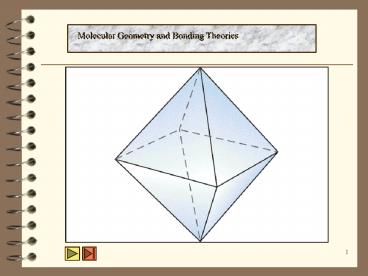Geometry ppt - PowerPoint PPT Presentation
1 / 43
Title:
Geometry ppt
Description:
Trigonal Planar. Bent. 15. Now Wait Just a Dipole Moment! = Qr, where is the ... Note that the bond angles are probably trigonal planar. This suggests an sp2 ... – PowerPoint PPT presentation
Number of Views:95
Avg rating:3.0/5.0
Title: Geometry ppt
1
Molecular Geometry and Bonding Theories
2
Molecular Geometry and Bonding Theories
- The overall shape of a molecule is determined by
its bond angles
3
Common Bonding Geometries
AB2
AB2
AB3
AB4
- Atoms (B) which are bonded to a central atom (A)
ABn
4
Valence Shell Electron Pair Repulsion Theory
VSEPR the best arrangement of a given number of
electron pairs is the one that minimizes the
repulsions among them.
Nonbonding pairs
Bonding pairs
5
Valence Shell Electron Pair Repulsion Theory
6
Valence Shell Electron Pair Repulsion Theory
7
VSEPRFour or Fewer Valence-Shell Electron Pairs
Around a Central Atom
8
VSEPRFour or Fewer Valence-Shell Electron Pairs
Around a Central Atom
9
VSEPRThe Effect of Nonbonding Electrons and
Multiple Bonds on Bond Angles
Nonbonding electron pairs exert greater repulsive
forces on adjacent electron pairs and thus tend
to compress the angles between the bonding pairs
Nonbonding electron pairs
2 Nonbonding electron pairs
107
104 .5
Ammonia (NH3)
Water (H2O)
10
VSEPRThe Effect of Nonbonding Electrons and
Multiple Bonds on Bond Angles
Multiple bonds, like nonbonding electron pairs,
exert a greater repulsive force on adjacent
electron pairs than do single bonds.
Formaldehyde (H2CO)
11
VSEPR Geometries of Molecules with Expanded
Valence Shells
When the central atom of an ABn molecule is from
the third period of the periodic table and
beyond, the atom may have more than four electron
pairs around it.
12
VSEPR Geometries of Molecules with Expanded
Valence Shells
13
VSEPR Geometries of Molecules with Expanded
Valence Shells
Note the placement of a single nonbonding
electron pair in an AB6 molecule is arbitrary.
The placement of two nonbonding pairs must be on
opposite sides of the octahedron.
14
VSEPR Molecules with No Single Central Atom
Tetrahedral
Trigonal Planar
Bent
..
H
H
..
C
O
H
H
C
H
15
Now Wait Just a Dipole Moment!
16
Dipole Moment The Polarity of Polyatomic
Molecules
The polarity of a molecule is dependent upon both
the polarities of the bonds and the geometry of
the molecule
17
Dipole Moment The Polarity of Polyatomic
Molecules
18
Covalent Bonding and Orbital Overlap Valence
Bond Theory
Valence Bond Theory unifies Lewis notion of
electron-pair bonds and the quantum notion of
atomic orbitals.
19
Covalent Bonding and Orbital Overlap Valence
Bond Theory
?-bonds results from the overlapping of two
s-orbitals, one from each atom.
?-bonds appear to be weaker than ?-bonds!
?-bonds
?-bonds
Formaldehyde (H2CO)
?-bonds result from the overlapping of two
p-orbitals, one from each atom. These covalent
bonds are constructed from overlapped regions
above and below the internuclear axis
20
Covalent Bonding and Orbital Overlap Hybrid
Orbitals
In order for an overlap to occur Beryllium must
provide unpaired electrons. This is accomplished
by promoting one of the 2S electrons
1s2 2s1 2p1
In order for each of the bonds to be identical,
the 2s1 and 2p1 orbitals become hybridized
21
Covalent Bonding and Orbital Overlap Hybrid
Orbitals (sp, BeF2)
Large lobes of sp hybrid orbitals
Be
Fluorine 2p orbitals
22
Covalent Bonding and Orbital Overlap Hybrid
Orbitals (sp2, BF3)
F
B
F
1s2 2s 2 2p1
23
Covalent Bonding and Orbital Overlap Hybrid
Orbitals (sp2, BF3)
In order for an overlap to occur Boron must
provide 3 unpaired electrons. This is
accomplished by promoting one of the 2S electrons
1s2 2s1 2p1
In order for each of the bonds to be identical,
the 2s1 and 2p1 orbitals become hybridized
1s2 2sp2 2p
24
Covalent Bonding and Orbital Overlap Hybrid
Orbitals (sp2, BF3)
25
Covalent Bonding and Orbital Overlap Hybrid
Orbitals (sp3, CH4)
1s2 2s2 2p1
promote
1s2 2s1 2p3
hybridize
1s2 sp3
26
Covalent Bonding and Orbital Overlap Hybrid
Orbitals (sp3, CH4)
27
Covalent Bonding and Orbital Overlap Hybrid
Orbitals (sp3d, PF5)
3s2 3p3 3d
promote
Phosphorous Pentafluoride (PF4)
3s2 3p3 3d
- Atoms in the third period and beyond can
- use their d orbitals
hybridize
3sp3d 3d
28
Geometrical Arrangements Characteristic of Hybrid
Orbitals
29
Geometrical Arrangements Characteristic of Hybrid
Orbitals
30
Hybrid Orbitals and Multiple Bonds Getting a
Piece of the ?,?
Consider the molecular geometry of ethylene
1s2 2s2 2p2
promote
1s2 2s1 2p3
hybridize
1s2 sp2 2p
- Note that the bond angles are probably trigonal
planar. This suggests an sp2 - configuration with one electron remaining in an
unhybridized 2p orbital
31
Hybrid Orbitals and Multiple Bonds Getting a
Piece of the ?,?
32
Hybrid Orbitals and Multiple Bonds Getting a
Piece of the ?,?
Consider the molecular geometry of acetylene
1s2 2s2 2p2
promote
1s2 2s1 2p3
hybridize
1s2 sp 2p2
- Note that the bond angles are probably linear.
This suggests an sp configuration - with each of the two remaining electrons
located in unhybridized 2p orbital
33
Hybrid Orbitals and Multiple Bonds Getting a
Piece of the ?,?
34
Hybrid Orbitals and Multiple Bonds Delocalized
Bonding
In noncyclic compounds, bonding electrons are
localized
35
Hybrid Orbitals and Multiple Bonds Delocalized
Bonding
Cyclic compounds resonate, in these cases the ?
bonds are delocalized
This molecules are particularly stable and are
described as aromatics
36
Molecular Orbitals Its Quantum Time!
antibonding orbitals
bonding orbitals
Contour Representations
37
Molecular Orbitals The Orbital Diagram
38
Molecular Orbitals The Orbital Diagram..HELP!
39
Molecular Orbitals The Orbital Diagram..OH MY
GOSH!!
40
Molecular Orbitals The Orbital Diagram..YIKES!!
41
Molecular Orbitals The Orbital Diagram..THATS
ITIM TOAST!!
42
Molecular Orbitals The Orbital
Diagram.._at_!!
43
(No Transcript)































